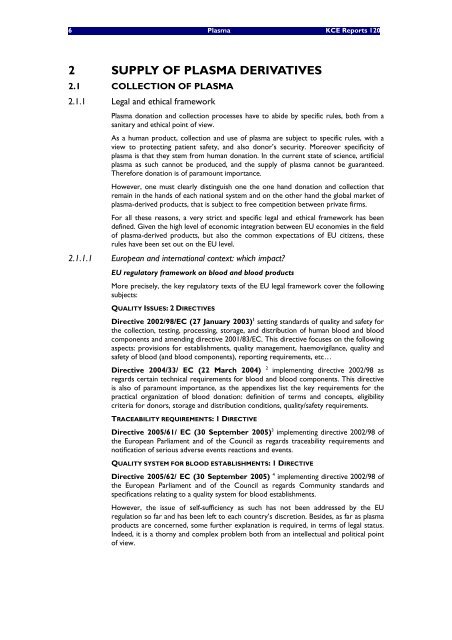The report is available in English with a Dutch summary - KCE
The report is available in English with a Dutch summary - KCE
The report is available in English with a Dutch summary - KCE
You also want an ePaper? Increase the reach of your titles
YUMPU automatically turns print PDFs into web optimized ePapers that Google loves.
6 Plasma <strong>KCE</strong> Reports 120<br />
2 SUPPLY OF PLASMA DERIVATIVES<br />
2.1 COLLECTION OF PLASMA<br />
2.1.1 Legal and ethical framework<br />
Plasma donation and collection processes have to abide by specific rules, both from a<br />
sanitary and ethical po<strong>in</strong>t of view.<br />
As a human product, collection and use of plasma are subject to specific rules, <strong>with</strong> a<br />
view to protect<strong>in</strong>g patient safety, and also donor’s security. Moreover specificity of<br />
plasma <strong>is</strong> that they stem from human donation. In the current state of science, artificial<br />
plasma as such cannot be produced, and the supply of plasma cannot be guaranteed.<br />
<strong>The</strong>refore donation <strong>is</strong> of paramount importance.<br />
However, one must clearly d<strong>is</strong>t<strong>in</strong>gu<strong>is</strong>h one the one hand donation and collection that<br />
rema<strong>in</strong> <strong>in</strong> the hands of each national system and on the other hand the global market of<br />
plasma-derived products, that <strong>is</strong> subject to free competition between private firms.<br />
For all these reasons, a very strict and specific legal and ethical framework has been<br />
def<strong>in</strong>ed. Given the high level of economic <strong>in</strong>tegration between EU economies <strong>in</strong> the field<br />
of plasma-derived products, but also the common expectations of EU citizens, these<br />
rules have been set out on the EU level.<br />
2.1.1.1 European and <strong>in</strong>ternational context: which impact?<br />
EU regulatory framework on blood and blood products<br />
More prec<strong>is</strong>ely, the key regulatory texts of the EU legal framework cover the follow<strong>in</strong>g<br />
subjects:<br />
QUALITY ISSUES: 2 DIRECTIVES<br />
Directive 2002/98/EC (27 January 2003) 1 sett<strong>in</strong>g standards of quality and safety for<br />
the collection, test<strong>in</strong>g, process<strong>in</strong>g, storage, and d<strong>is</strong>tribution of human blood and blood<br />
components and amend<strong>in</strong>g directive 2001/83/EC. Th<strong>is</strong> directive focuses on the follow<strong>in</strong>g<br />
aspects: prov<strong>is</strong>ions for establ<strong>is</strong>hments, quality management, haemovigilance, quality and<br />
safety of blood (and blood components), <strong>report</strong><strong>in</strong>g requirements, etc…<br />
Directive 2004/33/ EC (22 March 2004) 2 implement<strong>in</strong>g directive 2002/98 as<br />
regards certa<strong>in</strong> technical requirements for blood and blood components. Th<strong>is</strong> directive<br />
<strong>is</strong> also of paramount importance, as the appendixes l<strong>is</strong>t the key requirements for the<br />
practical organization of blood donation: def<strong>in</strong>ition of terms and concepts, eligibility<br />
criteria for donors, storage and d<strong>is</strong>tribution conditions, quality/safety requirements.<br />
TRACEABILITY REQUIREMENTS: 1 DIRECTIVE<br />
Directive 2005/61/ EC (30 September 2005) 3 implement<strong>in</strong>g directive 2002/98 of<br />
the European Parliament and of the Council as regards traceability requirements and<br />
notification of serious adverse events reactions and events.<br />
QUALITY SYSTEM FOR BLOOD ESTABLISHMENTS: 1 DIRECTIVE<br />
Directive 2005/62/ EC (30 September 2005) 4 implement<strong>in</strong>g directive 2002/98 of<br />
the European Parliament and of the Council as regards Community standards and<br />
specifications relat<strong>in</strong>g to a quality system for blood establ<strong>is</strong>hments.<br />
However, the <strong>is</strong>sue of self-sufficiency as such has not been addressed by the EU<br />
regulation so far and has been left to each country’s d<strong>is</strong>cretion. Besides, as far as plasma<br />
products are concerned, some further explanation <strong>is</strong> required, <strong>in</strong> terms of legal status.<br />
Indeed, it <strong>is</strong> a thorny and complex problem both from an <strong>in</strong>tellectual and political po<strong>in</strong>t<br />
of view.

















